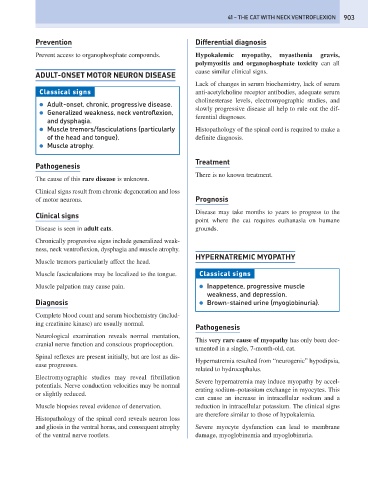Page 911 - Problem-Based Feline Medicine
P. 911
41 – THE CAT WITH NECK VENTROFLEXION 903
Prevention Differential diagnosis
Prevent access to organophosphate compounds. Hypokalemic myopathy, myasthenia gravis,
polymyositis and organophosphate toxicity can all
cause similar clinical signs.
ADULT-ONSET MOTOR NEURON DISEASE
Lack of changes in serum biochemistry, lack of serum
Classical signs anti-acetylcholine receptor antibodies, adequate serum
cholinesterase levels, electromyographic studies, and
● Adult-onset, chronic, progressive disease.
slowly progressive disease all help to rule out the dif-
● Generalized weakness, neck ventroflexion,
ferential diagnoses.
and dysphagia.
● Muscle tremors/fasciculations (particularly Histopathology of the spinal cord is required to make a
of the head and tongue). definite diagnosis.
● Muscle atrophy.
Treatment
Pathogenesis
There is no known treatment.
The cause of this rare disease is unknown.
Clinical signs result from chronic degeneration and loss
of motor neurons. Prognosis
Disease may take months to years to progress to the
Clinical signs
point where the cat requires euthanasia on humane
Disease is seen in adult cats. grounds.
Chronically progressive signs include generalized weak-
ness, neck ventroflexion, dysphagia and muscle atrophy.
HYPERNATREMIC MYOPATHY
Muscle tremors particularly affect the head.
Muscle fasciculations may be localized to the tongue. Classical signs
Muscle palpation may cause pain. ● Inappetence, progressive muscle
weakness, and depression.
Diagnosis ● Brown-stained urine (myoglobinuria).
Complete blood count and serum biochemistry (includ-
ing creatinine kinase) are usually normal.
Pathogenesis
Neurological examination reveals normal mentation,
This very rare cause of myopathy has only been doc-
cranial nerve function and conscious proprioception.
umented in a single, 7-month-old, cat.
Spinal reflexes are present initially, but are lost as dis-
Hypernatremia resulted from “neurogenic” hypodipsia,
ease progresses.
related to hydrocephalus.
Electromyographic studies may reveal fibrillation
Severe hypernatremia may induce myopathy by accel-
potentials. Nerve conduction velocities may be normal
erating sodium–potassium exchange in myocytes. This
or slightly reduced.
can cause an increase in intracellular sodium and a
Muscle biopsies reveal evidence of denervation. reduction in intracellular potassium. The clinical signs
are therefore similar to those of hypokalemia.
Histopathology of the spinal cord reveals neuron loss
and gliosis in the ventral horns, and consequent atrophy Severe myocyte dysfunction can lead to membrane
of the ventral nerve rootlets. damage, myoglobinemia and myoglobinuria.

